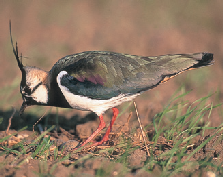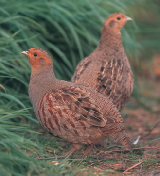




Farmland birds such as skylark, lapwing, grey partridge, tree sparrow, turtle dove, corn bunting, linnet, and yellowhammer.
Plus. Yellow wagtail; Reed bunting;
The Lapwing is hard to mistake, with its slow, flappy flight of flickering black and white and ‘pee-wit’ call, In spring, males have a tumbling display flight.
Close inspection reveals the iridescent green of the upper parts, purple and copper at the wing bends, a black and buff facial pattern, a wispy black crest and pink legs.
In spring and summer, breeding birds prefer mixed farmland, avoiding trees and hedges.
Preferred nesting crops include spring-drilled cereals, legumes, roots and rotational set-aside.
Lapwing do not nest in autumn- or winter-drilled cereals as these become too tall by the start of the breeding season.
Wet grasslands are an important breeding habitat and particularly if there is a nearby shallow area containing water.
In winter, permanent grassland, winter stubble and fallow fields are preferred by flocks of Lapwing, but if the weather is too harsh they move to Ireland, south-west England or to continental Europe.
Grey partridge has an orange brown face, grey breast and belly, all closely and finely barred, chestnut bars on the flanks and a curved horseshoe-shaped mark on the upper belly.
Grey Partridges nest on the ground in hedge bottoms, grass margins, game cover and nettle beds. Dead, tussocky grass left over from the previous year is particularly attractive as nesting cover.
Adult Grey Partridge feed on seeds and shoots throughout the year on areas such as rotational set-aside, winter stubble, weeds and crop margins.
The chicks need a diet of insects, especially caterpillars, bugs, ants and aphids, taken mainly from crop margins and weed areas.
The current UK population has dropped dramatically to less than 150,000 pairs due to loss of habitat for nesting and feeding - this being caused by modern farming practices.



Lapwing, Vanellus vanellus, are a familiar sight in pasture and wetlands appreciated by all. They are hard to mistake, with a slow, flappy flight of flickering black and white, and a ‘pee-wit’ call. Males have a tumbling display flight in spring. Close to, you can see the iridescent green of the upper parts, purple and copper at the wing bends, a black and buff facial pattern, a wispy black crest, and pink legs. It gathers in large flocks in winter in internationally important numbers.
Habitat. Lapwing nest on short vegetation and bare ground near damp or marshy areas and only raise one brood of young a year. They feed mainly on earthworms and insects and their larvae, including leatherjackets, found in abundance on grazed pasture and wet grassland.
Breeding Lapwing prefer mixed farmland, avoiding trees and hedges. Wet grasslands are an important breeding habitat, particularly if there is a nearby shallow area containing water.
Preferred nesting crops include spring-drilled cereals, legumes, roots and rotational set-aside. They do not nest in autumn- or winter-drilled cereals as these become too tall by the start of the breeding season.
In winter, permanent grassland, winter stubble and fallow fields are preferred by flocks of Lapwing, but if the weather is too harsh they move elsewhere.
Decline.
The historic decline of the species in the 19th century was due to changes in agriculture such as drainage, enclosures and egg gathering. The Lapwing Act (1926) greatly reduced the scale of egg gathering and combined with agricultural depression at the time, there was a rapid recovery in numbers. However as agricultural intensification increased during the 1960s, the numbers of Lapwings declined again: between 1987 and 1998, the breeding population dropped by 48% in England.
A number of changes in farming practices have had a serious effect on Lapwing populations:
- A reduction in mixed farming
- Loss of unimproved grassland and intensification of grassland management
- Loss of spring sown cereals
- An increase in livestock numbers and trampling rates
- Drainage of marginal grasslands
Status
Lapwing is a UK BAP and England S41 priority species because of its long term decline. It is on the red list of birds of conservation concern.
Protection.
The Lapwing is protected under the EC Birds Directive and under the Wildlife and Countryside Act 1981. It is an offence to kill and injure lapwing or to disturb it whilst nesting.
Progress. Land management by the RSPB in the the Lower Dearne Valley has created an improved and safe habitat for breeding Lapwing and has provided a safe winter roost for large numbers of birds. This is now being extended.
A survey completed in 2001 by volunteers was published by BBT in 2008 (BoCC).
Recording is carried out by BBSG as part of the forthcoming Barnsley Bird Atlas.
What can you do
BBT actions
- Encourage landowners to take up a stewardship scheme to benefit lapwing.
- Assess current coverage of DEFRA stewardship schemes that support Lapwing options with NE
- Extract information from BBSG BBS to provide populations and mapping of breeding Lapwing
Grey partridge has an orange brown face, grey breast and belly, all closely and finely barred, chestnut bars on the flanks and a curved horseshoe-shaped mark on the upper belly.

Lapwing
Grey Partridge nests on the ground beneath hedgerows in arable fields
Requires fine weather while chicks are small, wet summers cause high mortality rates amongst young birds
Although only one clutch is laid it may contain up to 20 eggs.
Chicks feed on insects, especially sawfly larvae, caterpillars, beetles, ants and aphids. Adults feed mainly on seeds and shoots.
Tree sparrow
The Tree Sparrow is distinguished from the closely related House Sparrow by its chestnut crown and its slightly smaller size. A bird of colonial habits, it has a restricted distribution in rural districts, preferring relatively open countryside with old trees and buildings where it will nest in holes and cavities. Occasionally, they build nests of dried grass and feathers in dense bushes. They will also use nest boxes.
Traditional nest site is a hole in a tree but will readily occupy nest boxes. Lays 2-8 eggs per clutch and can raise 2-3 broods each season. Adults feed mainly on seeds but chicks are fed on insects for the first tow weeks of life.
Tree Sparrow usually have two to three broods between April and August and feed the chicks on insects from a wide range of habitats including hedges, crops and waterside vegetation. Adults feed mainly on seeds which they seek from rotational setaside, winter stubbles, root crops, crop margins and weed areas.
In the past, Tree Sparrow populations have fluctuated, but recently at a more alarming rate. It is likely the reason for the decline is twofold:changing agricultural practices and loss of available nest sites,
the latter being borne out by the fact that nest boxes are readily occupied.
Corn bunting
Yellowhammer
Need to do’s